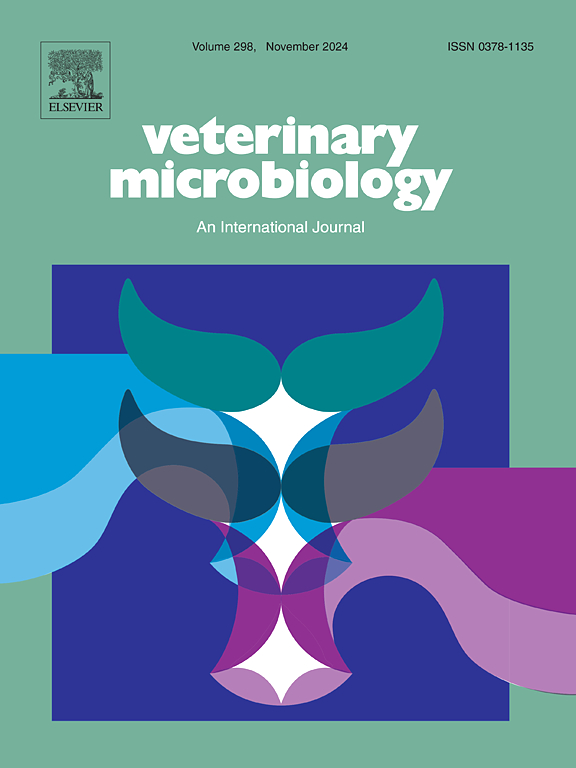Active surveillance for influenza A virus in swine reveals within-farm reassortment and cocirculation of distinct subtypes and genetic clades
IF 2.7
2区 农林科学
Q3 MICROBIOLOGY
引用次数: 0
Abstract
Influenza A virus (IAV) is one of the most frequently detected respiratory pathogens in swine. A passive surveillance system in the United States (U.S.) provides aggregated metrics to quantify spatial and temporal changes in genetic diversity. However, swine production is not homogenous: production systems vary in size and management strategies that affect the transmission and evolution of IAV. To assess how fine-scale variation affects IAV transmission, we conducted active surveillance on sow farms and linked nurseries from 4 U.S. production flows for up to 14 months. 85 complete HA sequences and 62 whole genomes with associated epidemiological information were generated. We conducted phylodynamic analyses and detected six genetic clades from four HA lineages: H1 1A classical swine, H1 1B human-seasonal, and H3 2010.1 and 1990.4. The H1 1B and H3 1990.4 showed evidence of transmission from sow farm to nursery. The H1 1A and H3 2010.1 viruses were detected in nurseries without a linked sow farm detection. Seven separate human-to-swine transmission events in the H1N1 pandemic clade (1A.3.3.2) in sow and nursery sites were identified. Nursery sites were infected with IAV that was both linked and unlinked to the sow farm. Control efforts may be impacted by subclinical IAV transmission in the breeding herd, the mixing of sow farm sources at the nursery, regional spread of new strains, and human-to-swine transmission. Regular surveillance activities within production systems provide the ability to match vaccine components to circulating diversity, thereby minimizing the opportunity for novel reassorted viruses to emerge and impact animal health.
对猪中甲型流感病毒的积极监测揭示了猪场内不同亚型和遗传分支的重组和共循环
甲型流感病毒(IAV)是猪最常见的呼吸道病原体之一。美国的一个被动监测系统提供了综合指标来量化遗传多样性的时空变化。然而,生猪生产并不是同质的:生产系统的规模和管理策略各不相同,这影响了IAV的传播和进化。为了评估细尺度变异如何影响IAV传播,我们对4个 美国的母猪场和相关苗圃进行了主动监测生产流程长达14个月。得到85个HA序列和62个具有相关流行病学信息的全基因组。我们进行了系统动力学分析,并从四个HA谱系中检测到6个遗传分支:H1 1A经典猪,H1 1B人类季节性,以及H3 2010.1和1990.4。H1 - 1B和H3 - 1990.4显示出从母猪场传播到苗圃的证据。在没有关联猪场检测的苗圃中检测到H1 1A和H3 2010.1病毒。在母猪和苗圃中确定了H1N1大流行支系(1A.3.3.2)中7个独立的人-猪传播事件。苗圃感染了与母猪场有关联和无关联的IAV。禽流感病毒在种猪群中的亚临床传播、苗圃中猪场源的混合、新毒株的区域传播以及人-猪传播可能会影响控制工作。生产系统内的定期监测活动提供了使疫苗成分与流行多样性相匹配的能力,从而最大限度地减少了出现新的重组病毒并影响动物健康的机会。
本文章由计算机程序翻译,如有差异,请以英文原文为准。
求助全文
约1分钟内获得全文
求助全文
来源期刊

Veterinary microbiology
农林科学-兽医学
CiteScore
5.90
自引率
6.10%
发文量
221
审稿时长
52 days
期刊介绍:
Veterinary Microbiology is concerned with microbial (bacterial, fungal, viral) diseases of domesticated vertebrate animals (livestock, companion animals, fur-bearing animals, game, poultry, fish) that supply food, other useful products or companionship. In addition, Microbial diseases of wild animals living in captivity, or as members of the feral fauna will also be considered if the infections are of interest because of their interrelation with humans (zoonoses) and/or domestic animals. Studies of antimicrobial resistance are also included, provided that the results represent a substantial advance in knowledge. Authors are strongly encouraged to read - prior to submission - the Editorials (''Scope or cope'' and ''Scope or cope II'') published previously in the journal. The Editors reserve the right to suggest submission to another journal for those papers which they feel would be more appropriate for consideration by that journal.
Original research papers of high quality and novelty on aspects of control, host response, molecular biology, pathogenesis, prevention, and treatment of microbial diseases of animals are published. Papers dealing primarily with immunology, epidemiology, molecular biology and antiviral or microbial agents will only be considered if they demonstrate a clear impact on a disease. Papers focusing solely on diagnostic techniques (such as another PCR protocol or ELISA) will not be published - focus should be on a microorganism and not on a particular technique. Papers only reporting microbial sequences, transcriptomics data, or proteomics data will not be considered unless the results represent a substantial advance in knowledge.
Drug trial papers will be considered if they have general application or significance. Papers on the identification of microorganisms will also be considered, but detailed taxonomic studies do not fall within the scope of the journal. Case reports will not be published, unless they have general application or contain novel aspects. Papers of geographically limited interest, which repeat what had been established elsewhere will not be considered. The readership of the journal is global.
 求助内容:
求助内容: 应助结果提醒方式:
应助结果提醒方式:


